There are distinct kinds of ducks across Florida. There are various explanations for this; however, the most plausible is that the state contains many different types of wetlands. Saltwater marshes, freshwater marshes, and also coastal locations are examples.
Ducks, famous for their kind temperament, still have the greatest number of any waterfowl family. Domesticated for their meat and eggs, these lovely aquatic birds are frequently owned as pets.
There are many ducks all around Florida, and there are numerous distinct kinds to distinguish.
Several of them remain in Florida throughout the year, whereas others might be seen during their journey.
Additionally, there are a few types that exclusively visit Florida during the winter.
Today, we’ll look at different types of ducks in Florida.
| Image | Name |
|---|---|
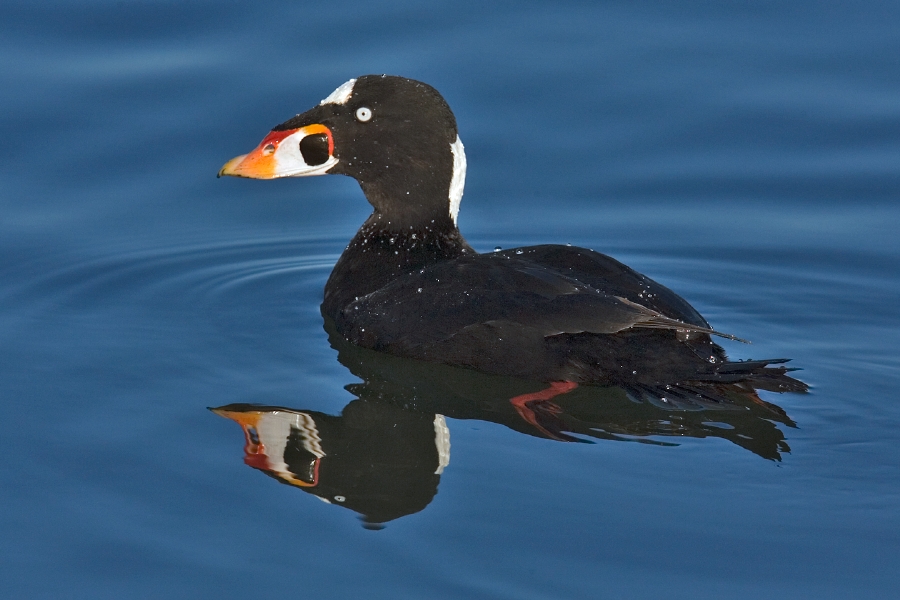 | Surf Scoter |
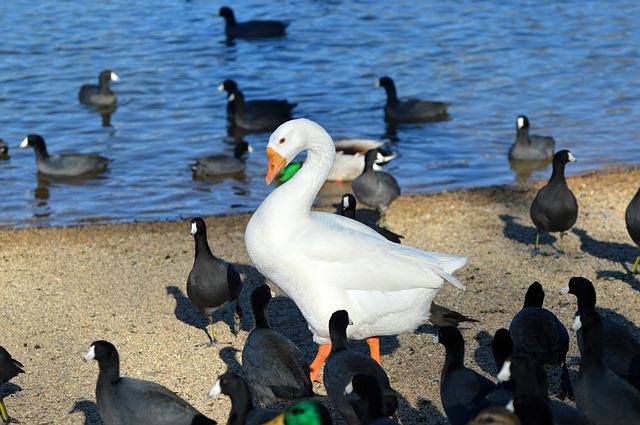 | American Black Duck |
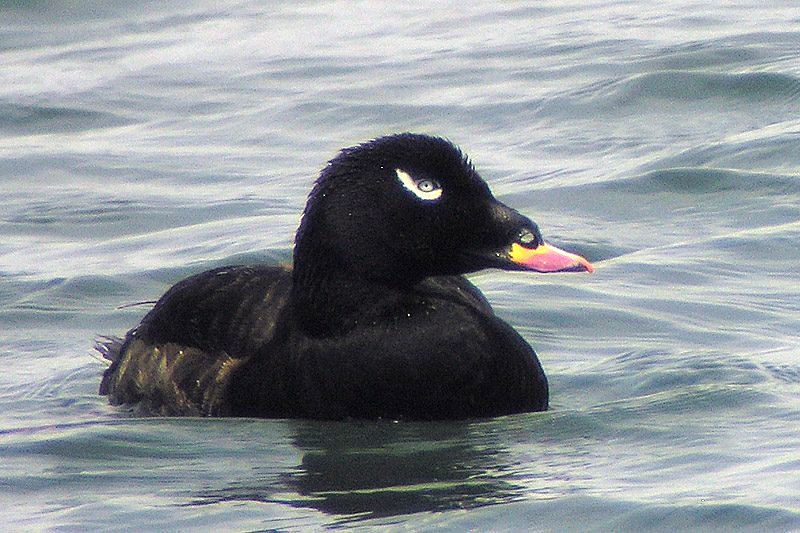 | White-Winged Scoter |
 | Mallard |
 | Ruddy Duck |
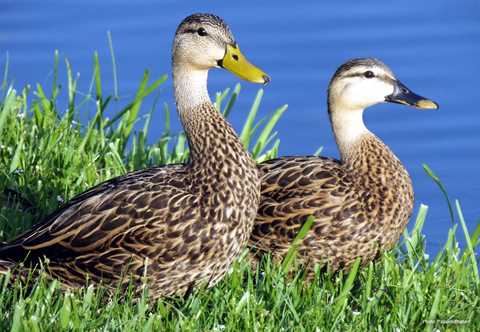 | Mottled Duck |
 | Canvasback |
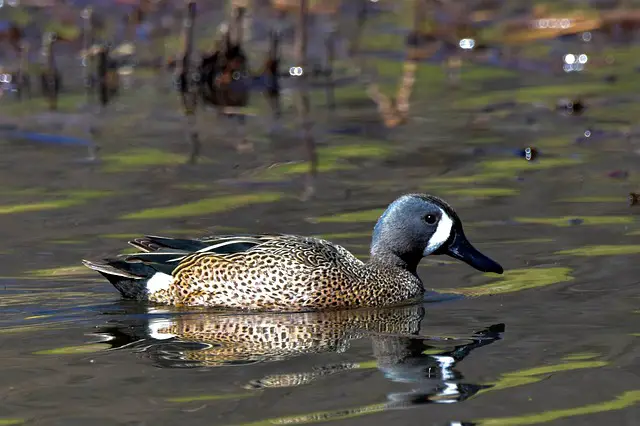 | Blue Wings Teal |
 | Redhead |
 | Wood Duck |
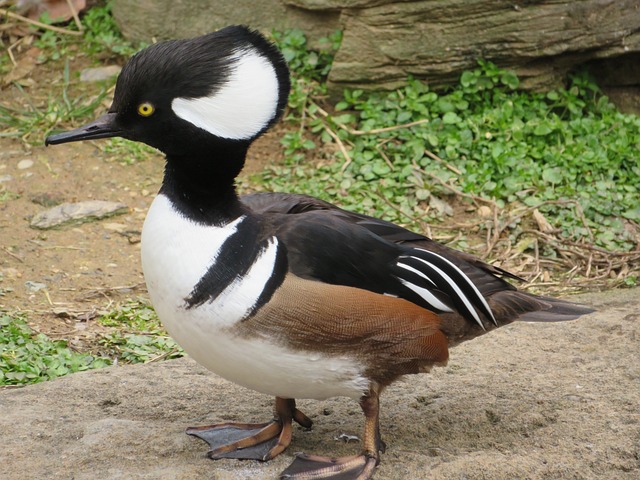 | Hooded Merganser |
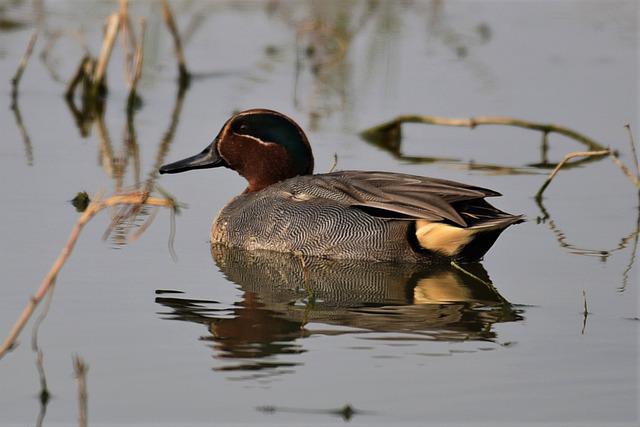 | Green-Winged Teal |
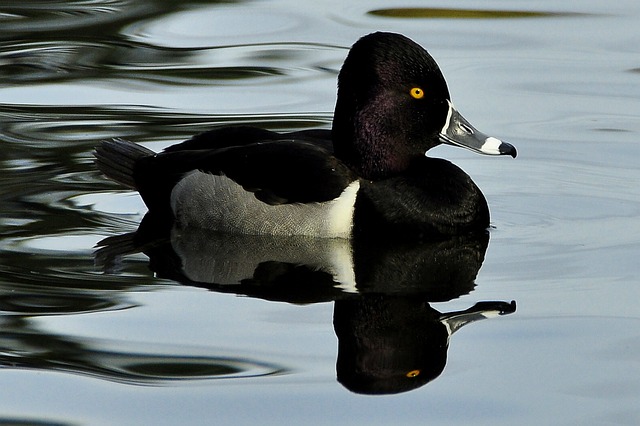 | Ring-Necked Duck |
Types of Ducks in Florida
Ducks have emerged as one of Florida’s most attractive visitor attractions. You might probably spend a day seeing various varieties of ducks due to the number of species and distinguishing characteristics.
Without any further ado, below are the fifteen distinct types of ducks you can see in Florida.
1. Surf Scoter

Surf Scoters may be located all across North America. They commonly practice yearlong monogamy and exchange partners every year. They have been seen interbreeding with Redheads and Canvasbacks.
The Surf Scoter is named because of its distinctive black feathers all over its back, which mimic ocean waves.
Males get a white breast and abdomen, as well as a black neck and head. Male beaks are mottled with orange, red, and white. Females appear predominantly dark, having white splotches over their foreheads.
Diet
Surf Scoters are typically omnivorous, eating a wide range of animal and plant debris, including tiny crabs, mollusks, fish, and herring eggs.
| Scientific Name | Melanitta perspicillata |
| Weight | 1 to 3 lbs |
| Wingspan | 31 inches |
| Habitat | Ponds that are Freshwater |
| Life Expectancy | 10 Years |
2. American Black Duck

American Black Ducks are among the biggest ducks within the Anas family, and they are approximately the same proportion as Mallards. They are only reported to produce offspring with mallards.
This species’ birds have all had a black appearance. Males possess dark greenish heads, whereas females possess dark brownish heads.
Females have a dark blue shoulder speculum that is surrounded by white plumage. The underwing plumes of males are usually white.
Diet
These omnivorous ducks consume a wide range of animal and plant stuff, including snails, roots, leaves, seeds, berries, and tiny crustaceans.
| Scientific Name | Anas rubripes |
| Weight | 2 to 3 lbs |
| Wingspan | 38 inches |
| Habitat | Ponds, Rivers, and Lakes |
| Life Expectancy | 10 years inside the wild, then 20 years under captivity |
3. White-Winged Scoter

White-Winged Scoters may be seen all over North America. They have been seen interbreeding with certain other duck varieties, including Pintails and Redheads.
The White-Winged Scoter is named after its distinctive white feathers all over its wings. Males get a black body and head as well as white eye lines and even a speculum.
Females appear brown and have the same whitish speculum as males.
Diet
White-Winged Scoters are primarily omnivores, eating a wide range of animal and plant items, including tiny fish, mollusks, and crabs.
| Scientific Name | Melanitta deglandi |
| Weight | 2 to 4 lbs |
| Wingspan | 37 inches |
| Habitat | Lakes, ponds, marshland, and sometimes even cities |
| Life Expectancy | 12 years within habitat; 20 years under captivity |
4. Mallard

Mallards are among the most common duck in the world, and they can be found across every continent, excluding Antarctica. They have also been seen interbreeding with numerous other duck varieties.
Mallards may be identified by their shiny greenish heads and white necks. Males possess black feathers with a chestnut chest, whereas females possess brown to grey feathers and a white chest.
The males and females both possess a black tail as well as a blue wings speculum.
Diet
Mallards are primarily omnivorous, eating insects such as beetles, caddisflies, flies, and dragonflies. Insects and tiny crustaceans are also eaten.
| Scientific Name | Anas platyrhynchos |
| Weight | 2 and 4 lbs |
| Wingspan | 43 inches |
| Habitat | Lakes, wetlands, pools, and perhaps even urban areas serve as the environment. They live in both saltwater and freshwater environments |
| Life Expectancy | 10 years, mostly in the wild; twenty years in small cages. |
5. Ruddy Duck

Ruddy Ducks may be located all across South and North America. They have been seen interbreeding with certain other waterfowl species, including Canvasbacks and Redheads.
The Ruddy Duck is named because of the reddish feathers all over its neck and head. Males get a black forehead and chest, as well as a white collar and abdomen.
They possess purple beaks as well. Females appear identical; however, their feathers have a brown tone.
Diet
Ruddy Ducks are generally omnivorous, eating a wide range of animal and plant items, including aquatic plants, zooplankton, tiny fish, and insects.
| Scientific Name | Oxyura jamaicensis |
| Weight | 1 to 2 lbs |
| Wingspan | 20 inches |
| Habitat | Ponds, marshes, and lakes |
| Life Expectancy | 13 Years |
6. Mottled Duck

Mottled Ducks represent the only ducks mostly in the Anas genus that can only be located across North America. They have been seen breeding alongside Mallards and Blue-Winged Teals.
The title Mottled Duck comes from its striking mottled feathers. The males’ heads and necks are grey. Their speckled plumage covers the remainder of their bodies. Females are identical to males; however, they possess silvered heads and brilliant beaks.
Diet
This duck is typically omnivorous, eating a wide range of animal and plant stuff, including acorns, seeds, insects, and small animals.
| Scientific Name | Anas fulvigula Ridgway |
| Weight | 2 to 3 lbs |
| Wingspan | 38 inches |
| Habitat | Wetlands, lakes, and ponds are suitable habitats |
| Life Expectancy | 5 years within the wild, 20 years under captivity |
7. Canvasback

Canvasback Ducks are also the biggest ducks within the Aythya genus, and they may be spotted all across North America. They commonly practice yearlong monogamy and exchange partners every year.
They have also been seen interbreeding with other duck species, including Pintails and Redheads.
The Canvasback Duck is named after its distinctive white feathers all over its back. Males get a red neck and head as well as a white breasts and abdomen. Females appear brown, having deeper brown speckles on their throats and beneath their plumage.
Diet
Canvasback Ducks consume a variety of foods, including roots, insect larvae, snails, seeds, and tubers.
| Scientific Name | Aythya valisineria |
| Weight | 2 to 4 lbs |
| Wingspan | 34 inches |
| Habitat | Lakes, saltwater marshes, wetlands, and ports are all examples of freshwater bodies |
| Life Expectancy | 14 Years |
8. Blue Wings Teal

Blue-Winged Teals belong to the tiniest ducks within the Anas genus, and they may be spotted all over South and North America. They have been seen interbreeding with Mottled Ducks and Mallards.
The Blue-Winged Teal is named after the bright blue feathers over its wings. Males possess grey heads and chests with white necks and bellies. Females are identical; however, their feathers have a brownish tone. A bluish-winged speculum is present in both males and females.
Diet
Blue-Winged Teals are primarily omnivorous, eating a wide range of animal and plant items, including acorns, insects, seeds, and small animals.
| Scientific Name | Anas discors |
| Weight | 1 to 2 lbs |
| Wingspan | 28 inches |
| Habitat | Lakes, ponds, marshland, as well as urban areas having calm waterways and lush flora, serve as excellent habitats |
| Life Expectancy | 17 Years |
9. Redhead

Redhead Ducks may be found all across South and North America. They have been seen interbreeding with certain other duck varieties, including Pintails and Mallards.
The Redhead Duck gets named because of the bright red feathers over its head. Males get a red chest and head as well as a black throat and abdomen, while females possess brown skulls and throats.
Diet
Redhead Ducks are typically omnivorous, eating mostly animal stuff, including insect larvae and mollusks, and only a tiny amount of plant food, such as insect larvae, acorns, seeds, and tiny animals.
| Scientific Name | Aythya americana |
| Weight | 2 to 3 lbs |
| Wingspan | 32 inches |
| Habitat | Ponds, wetlands, freshwater river systems, and dams are all examples of bodies of water |
| Life Expectancy | 2 years in the wild followed by 10 years in captivity |
10. Wood Duck

The one and only ducks of the Aix genus species are wood ducks, which are widespread across North America. They have been seen interbreeding with Mallards.
Wood Ducks are readily identified by their unique heads. Males possess greenish heads, brown breasts, and cheeks featuring white and black patterns. Females are identical, but they have a duller coloring. Males possess darker skulls and fewer evergreens than females.
Diet
These ducks are primarily omnivorous, eating a wide range of animal and plant stuff, including vegetables, acorns, berries, seeds, insects, and small animals.
| Scientific Name | Aix sponsa |
| Weight | 2 to 3 lbs |
| Wingspan | 30 inches |
| Habitat | Ponds, waterways, overflowing beaver ponds, as well as lakes provide habitats |
| Life Expectancy | 4 years on average; however, a few have survived to be fifteen |
11. Hooded Merganser

Hooded Mergansers are indeed the sole ducks within the genus Lophodytes, and they may be discovered all over North America.
They have been seen interbreeding with several other merganser species.
The Hooded Merganser originally comes from the unique feathered hood which adorns its forehead. Males get a black chest and head, as well as a white throat and abdomen.
The heads, necks, and breasts of the females are brown. A blue-wing speculum is present across both males and females.
Diet
Hooded Mergansers have been omnivorous predators that scavenge through eyesight. Fish, crabs, crayfish, frogs, and aquatic insects are among their favorite foods.
| Scientific Name | Lophodytes cucullatus |
| Weight | 2 to 3 lbs |
| Wingspan | 27 inches |
| Habitat | Streams, pools, and woodland lakes |
| Life Expectancy | 13 years |
12. Green-Winged Teal

Green-Winged Teals also seem to be another among the Anas genus’ tiniest ducks, widespread across South and North America. They also have offspring with Mallards and Mottled Ducks.
The title Green-Winged Teal comes from the bright green feathers all over its wingspan. Males get a green and brown forehead, a silvery breasts, and a white collar and stomach.
Females appear comparable, although their feathers have a brown tone. Females possess brown heads, which is a big distinction. A greenish-wing speculum is worn by both males and females.
Diet
Green-Winged Teals consume seeds, stems, nutgrasses, wheat, barley, pondweeds, and spike rushes as their primary food.
| Scientific Name | Anas carolinensis |
| Weight | 1 to 2 lbs |
| Wingspan | 22 to 23 inches |
| Habitat | Lakes, ponds, marshes, and grassy nests are all close |
| Life Expectancy | 20 Years |
13. Ring-Necked Duck

Ring-Necked Ducks may be spotted all across South and North America. They have been seen interbreeding with Mottled Ducks and Mallards.
Ring-Necked Shirt, the prominent circle of white feathers around its throat, gives the duck its nickname.
Males get a black forehead, breast, and abdomen with a white underbelly. Females appear identical, but they have a duller coloring. A bluish-wing speculum is present among both males and females.
Diet
Ring-Necked Ducks are omnivores, eating a wide range of plant and animal debris, including acorns, insects, seeds, and small animals.
| Scientific Name | Aythya collaris |
| Weight | 2 to 3 lbs |
| Wingspan | 29 inches |
| Habitat | Lakes, fens, and bogs |
| Life Expectancy | 10 years within wilderness; 20 years under captivity |
Check out this article on Types of Ducks in Michigan and Types of Ducks in Texas.
Conclusion
Ducks are a prominent sort of bird that may be located all over the globe. Each duck seems to have distinct feathers and temperament.
Florida Ducks are recognized to interbreed across various duck species and often dwell in couples or organized numbers.
Male and female foliage variations are noticeable within every duck species. Males are generally brilliantly colored to attract mates, whilst females are typically drabberly colored.
To defend their offspring from threats, females must be carefully hidden.
Ducks are unusual creatures with a variety of intriguing characteristics. Keep a look out for these intriguing animals if you happen to be in Florida! However, do not feed them.
FAQ
What are the most frequent ducks throughout Florida?
Non-migratory and migrating ducks may be found in Florida. Mallard ducks, Florida mottled ducks, black-bellied whistling ducks, and wood ducks are among the most frequent duck types across central Florida.
What exactly are the large black ducks throughout Florida?
Wild Muscovy Ducks species are forest residents that nest within tree holes and therefore are shiny black featuring prominent white wing spots. In the 1980s, their distribution increased in Texas, although feral populations may also be seen throughout Florida.
Last Updated on March 22, 2023 by Lily Aldrin
